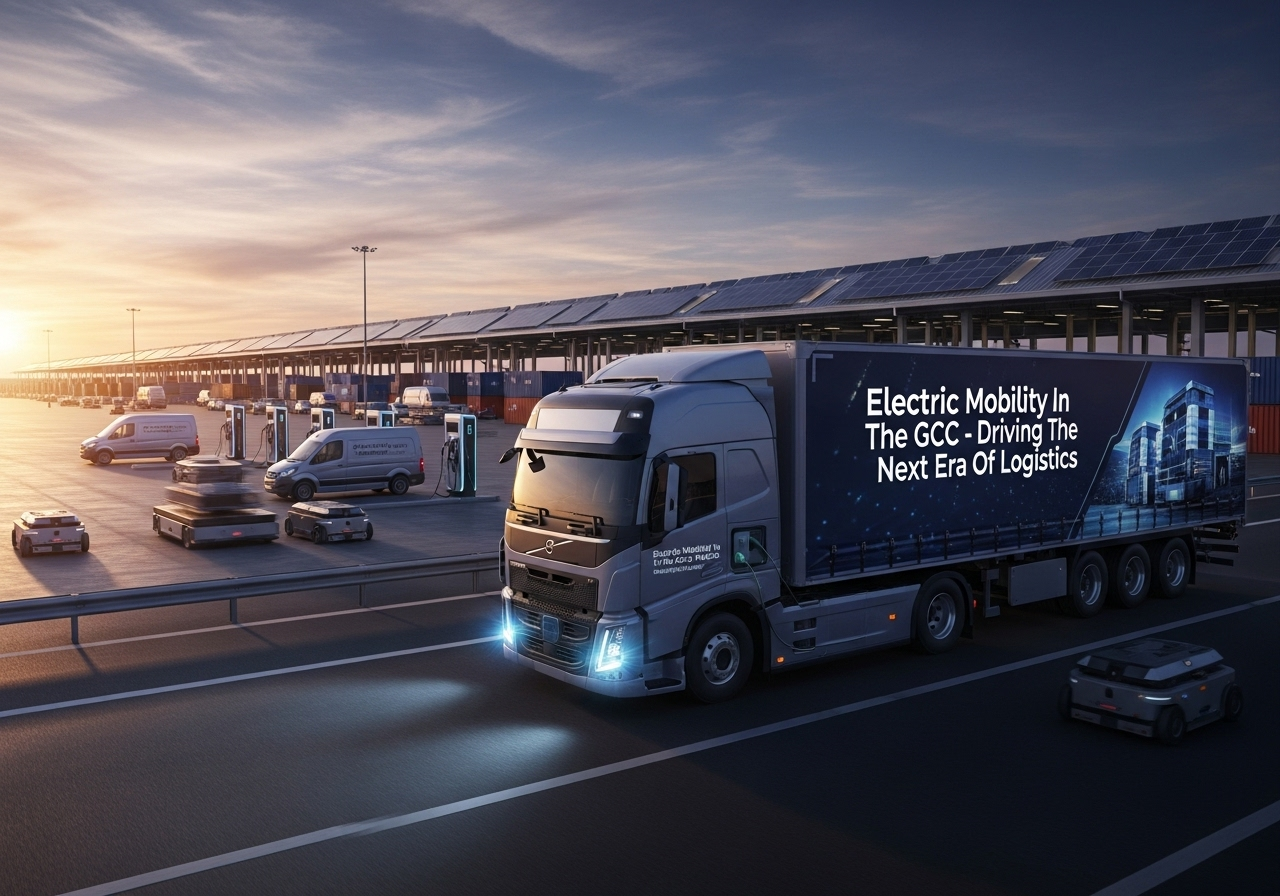Electric Transportation In Gulf Countries
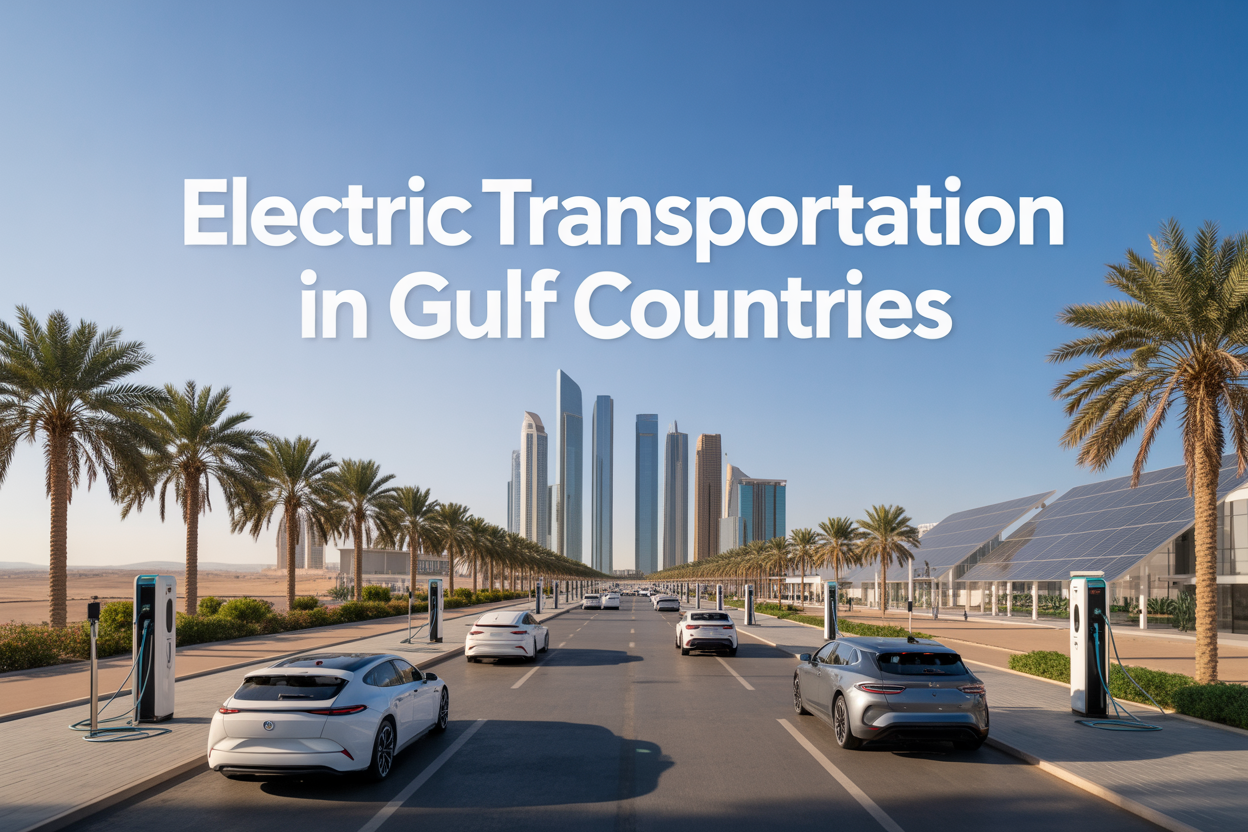
Electric transportation in Gulf countries is gaining serious momentum as nations across the region accelerate their shift toward sustainable mobility solutions. This guide is designed for policymakers, business leaders, automotive industry professionals, and investors who want to understand the rapidly evolving electric vehicle landscape in the Gulf Cooperation Council (GCC) states.
The Gulf region is experiencing a remarkable transformation in how people and goods move from place to place. Countries like the UAE, Saudi Arabia, and Qatar are investing billions in electric transportation infrastructure while rolling out ambitious policies to support widespread adoption.
We’ll explore the current state of electric vehicle adoption across Gulf nations, examining which countries are leading the charge and where opportunities exist for growth. You’ll also discover how government policies are driving this transformation, from generous incentives to mandatory EV quotas that are reshaping the automotive market. Finally, we’ll dive into the charging infrastructure development happening across the region, including the massive investments being made to ensure drivers can charge their vehicles conveniently anywhere they go.
Current State of Electric Vehicle Adoption Across Gulf Nations
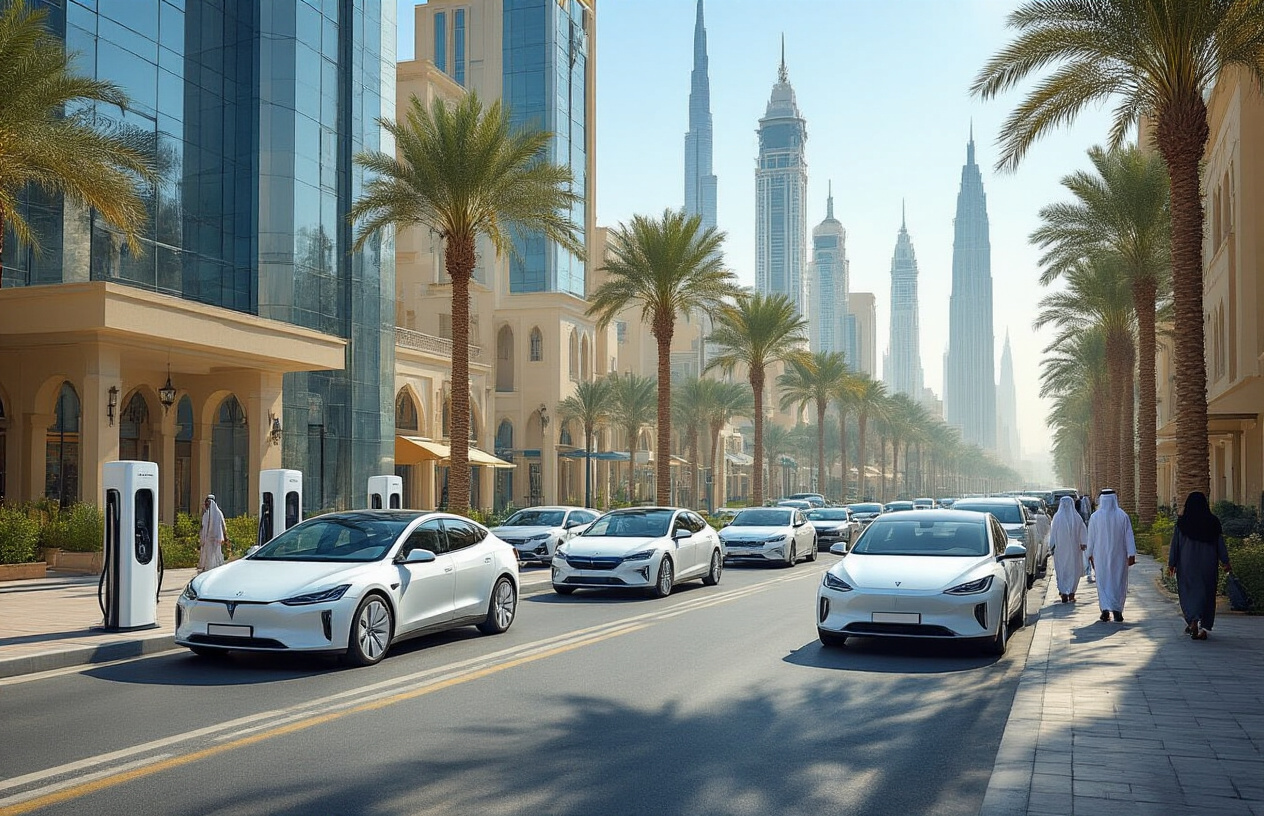
UAE Leading the Regional EV Market Transformation
The United Arab Emirates has emerged as the Gulf region’s electric vehicle pioneer, with Dubai and Abu Dhabi driving significant adoption rates. The country now hosts over 15,000 registered electric vehicles, representing the highest concentration in the GCC region. Tesla Model 3 and Model S dominate the luxury segment, while BMW i3 and Nissan Leaf capture the mid-range market.
Dubai’s ambitious Green Mobility Strategy 2030 targets 10% of all government fleet vehicles to be electric by 2025. The emirate has already converted 20% of its taxi fleet to hybrid and electric models, with plans to reach 50% by 2026. Abu Dhabi follows closely with its own sustainability initiatives, focusing on electric buses for public transportation.
The UAE’s strategic location as a regional hub has attracted major automotive manufacturers to establish EV operations. BYD opened its first Middle East assembly facility in Abu Dhabi, while Lucid Motors chose the country for its regional headquarters. These investments have created a ripple effect, encouraging local dealerships to expand their electric vehicle offerings and service capabilities.
Private sector adoption shows promising growth, with luxury car buyers increasingly choosing electric models. The country’s affluent population and tax-free environment make EVs financially attractive, especially when considering long-term operational savings.
Saudi Arabia’s Massive Investment in Electric Infrastructure
Saudi Arabia has committed $20 billion to electric vehicle infrastructure development as part of its Vision 2030 program. The kingdom aims to produce 500,000 electric vehicles annually by 2030, positioning itself as a regional manufacturing hub. NEOM, the futuristic city project, will operate entirely on renewable energy with autonomous electric transportation systems.
The Public Investment Fund has partnered with Lucid Motors to establish a manufacturing facility in Riyadh, expected to produce 150,000 vehicles annually by 2025. This partnership includes technology transfer agreements and local workforce development programs. Additionally, Saudi Arabia has signed agreements with Chinese manufacturers including BYD and Geely to establish assembly operations.
The Saudi Green Initiative includes plans for 500,000 EV charging points nationwide by 2030. The first phase focuses on major cities and highway corridors, with 10,000 charging stations already operational. ARAMCO has pivoted its strategy to include EV charging networks, leveraging its existing fuel station infrastructure for rapid deployment.
Government fleet electrification has begun with pilot programs in Riyadh and Jeddah. The Ministry of Interior has ordered 5,000 electric patrol vehicles, while the Ministry of Health is testing electric ambulances in urban areas. These initiatives demonstrate the kingdom’s commitment to leading by example in the transition to sustainable transportation.
Qatar’s Strategic EV Integration for Sustainable Development
Qatar’s National Vision 2030 includes specific targets for electric vehicle adoption as part of its environmental sustainability goals. The country has established a comprehensive EV roadmap with incentives for both individual and fleet purchases. Qatar Foundation has committed to electrifying its entire vehicle fleet by 2025, serving as a model for other organizations.
The 2022 FIFA World Cup showcased Qatar’s electric transportation capabilities, with over 800 electric buses serving tournament venues. This infrastructure remains operational, providing sustainable public transportation for residents and visitors. Qatar Airways has also invested in electric ground support vehicles at Hamad International Airport, reducing emissions from airport operations.
Kahramaa, Qatar’s utility company, has installed smart charging stations across Doha and other major cities. The network includes both AC and DC fast-charging options, with plans to expand to 2,000 charging points by 2025. The integration with Qatar’s smart grid allows for optimized charging during off-peak hours, reducing strain on the electrical system.
Private sector partnerships have accelerated EV adoption, with major employers offering workplace charging facilities. Qatar Petroleum and other large corporations have begun transitioning their vehicle fleets, creating demand for local EV services and maintenance capabilities.
Kuwait and Bahrain’s Emerging Electric Transportation Initiatives
Kuwait has launched its National Electric Vehicle Strategy with targets to have 15% of new vehicle sales be electric by 2030. The Kuwait Investment Authority has allocated $2 billion for clean transportation projects, including EV charging infrastructure and incentive programs. The government offers reduced registration fees and free parking for electric vehicles in public areas.
Kuwait Petroleum Corporation is piloting electric vehicle charging stations at select fuel stations, with plans to expand across the country. The company is also testing electric delivery vehicles for its retail operations. Kuwait University has established an Electric Vehicle Research Center, focusing on battery technology and charging optimization for desert climates.
Bahrain’s Economic Vision 2030 includes electric transportation as a key component of its sustainability strategy. The kingdom has partnered with regional investors to establish EV assembly operations, targeting both domestic consumption and export to neighboring countries. The Bahrain Airport Company has introduced electric shuttle buses and is testing autonomous electric vehicles for passenger transport.
Both countries face unique challenges due to their smaller markets and limited manufacturing capabilities. However, their strategic positions as regional financial and logistics hubs provide opportunities for EV-related services and technology development. Regional cooperation initiatives are exploring shared charging networks and standardized regulations to accelerate adoption across both nations.
Government Policies Driving Electric Transportation Growth
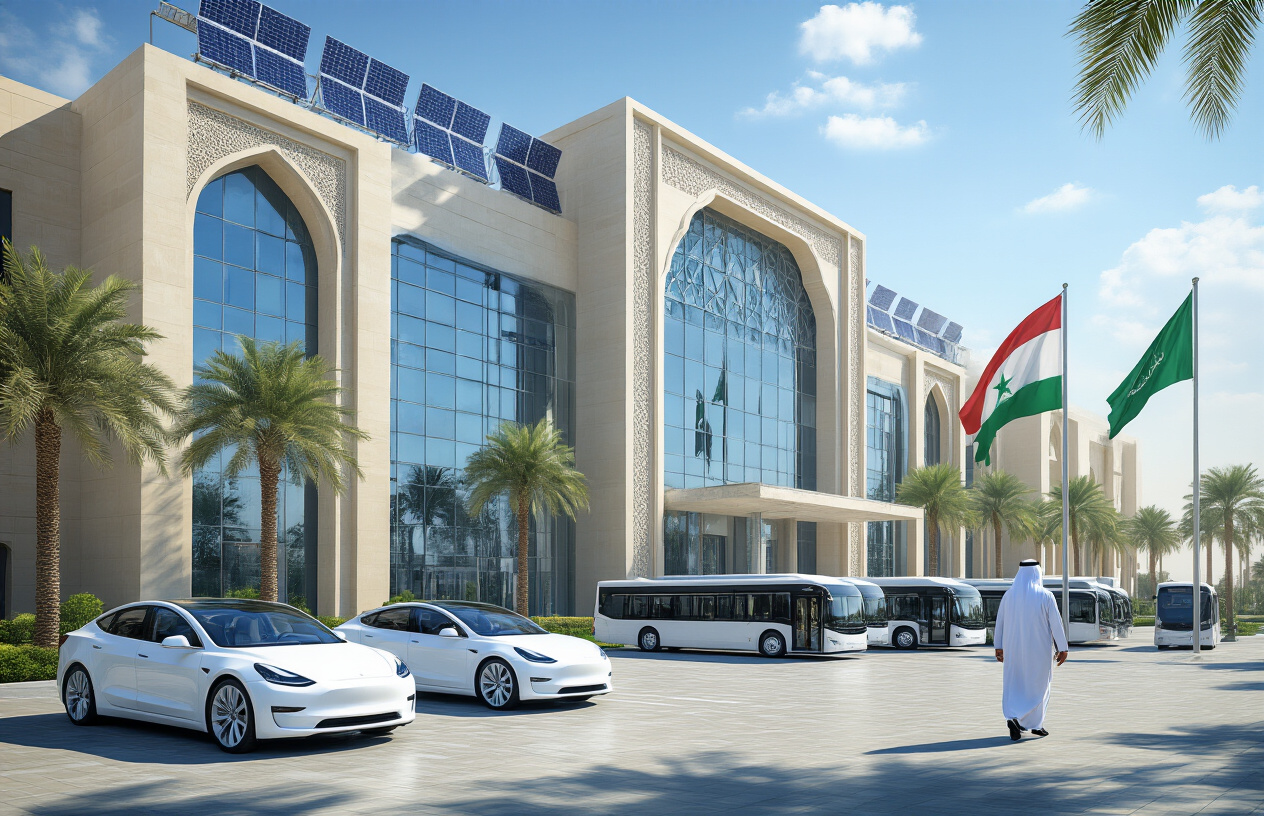
Tax Incentives and Import Duty Reductions for EV Buyers
Gulf governments have rolled out comprehensive financial incentives to make electric vehicles more accessible to consumers. The UAE leads the charge with complete exemption from customs duties on electric and hybrid vehicles, while Dubai offers free registration, licensing, and Salik (toll) tag services. Kuwait provides substantial import duty reductions of up to 90% for fully electric vehicles, alongside reduced insurance premiums.
Saudi Arabia’s approach includes customs duty exemptions for electric vehicles and preferential financing rates through government-backed programs. Qatar eliminates import duties entirely for EVs and offers reduced annual registration fees. These incentives create significant cost savings – buyers can save between $3,000 to $15,000 depending on the vehicle category and country.
The financial benefits extend beyond purchase incentives. Several Gulf states provide reduced electricity rates for EV charging during off-peak hours. Bahrain offers free parking in designated areas for electric vehicle owners, while Oman provides reduced vehicle inspection fees and extended warranty requirements for EVs.
| Country | Import Duty Reduction | Additional Benefits |
|---|---|---|
| UAE | 100% exemption | Free registration, toll exemption |
| Saudi Arabia | 100% exemption | Preferential financing rates |
| Kuwait | Up to 90% reduction | Reduced insurance premiums |
| Qatar | 100% exemption | Reduced registration fees |
Regulatory Frameworks Supporting EV Infrastructure Development
Gulf nations have established robust regulatory frameworks that streamline the deployment of charging infrastructure. The UAE’s Federal Electricity and Water Authority (FEWA) has created standardized technical specifications for public charging stations, ensuring compatibility across different vehicle brands and charging networks.
Saudi Arabia’s National Industrial Development and Logistics Program mandates that all new residential and commercial developments include EV charging capabilities. The kingdom’s building codes now require pre-wiring for charging stations in parking facilities, reducing future installation costs and complexity.
Qatar’s regulatory framework includes fast-track permitting processes for charging station installations, cutting approval times from months to weeks. The country has established clear guidelines for grid connection requirements and safety standards that align with international best practices.
Kuwait has introduced zoning regulations that designate specific areas for charging infrastructure development, while also requiring fuel stations to allocate space for electric charging points. These regulations ensure strategic placement of charging facilities along major transportation corridors.
Standardization efforts across the Gulf Cooperation Council focus on creating unified charging protocols and payment systems. This regional approach allows for seamless cross-border electric vehicle travel and reduces infrastructure development costs through economies of scale.
National Vision Plans Incorporating Clean Transportation Goals
Electric transportation plays a central role in each Gulf nation’s long-term strategic vision. Saudi Arabia’s Vision 2030 aims to achieve 30% electric vehicle adoption by 2030, with specific targets for government fleet electrification and public transportation systems. The kingdom plans to establish a domestic EV manufacturing industry as part of its economic diversification goals.
UAE’s Energy Strategy 2050 incorporates ambitious targets for clean transportation, including the conversion of 42% of vehicles to clean energy by 2050. Dubai’s Clean Energy Strategy specifically targets 25% of all transportation to be smart and autonomous by 2030, with significant emphasis on electric mobility solutions.
Qatar’s National Vision 2030 integrates sustainable transportation as a key pillar of environmental development. The country has committed to electrifying its entire public bus fleet and achieving carbon neutrality in preparation for hosting major international events.
Kuwait’s New Kuwait Vision 2035 emphasizes sustainable urban development with clean transportation systems. The plan includes specific milestones for EV adoption rates and infrastructure deployment timelines.
These national visions create accountability frameworks with measurable targets, dedicated budgets, and inter-ministerial coordination mechanisms. Each country has established specialized committees to oversee implementation, ensuring that electric transportation goals align with broader economic and environmental objectives. The integration of these targets into national planning processes demonstrates the Gulf region’s serious commitment to transportation electrification beyond simple policy statements.
Charging Infrastructure Development and Expansion
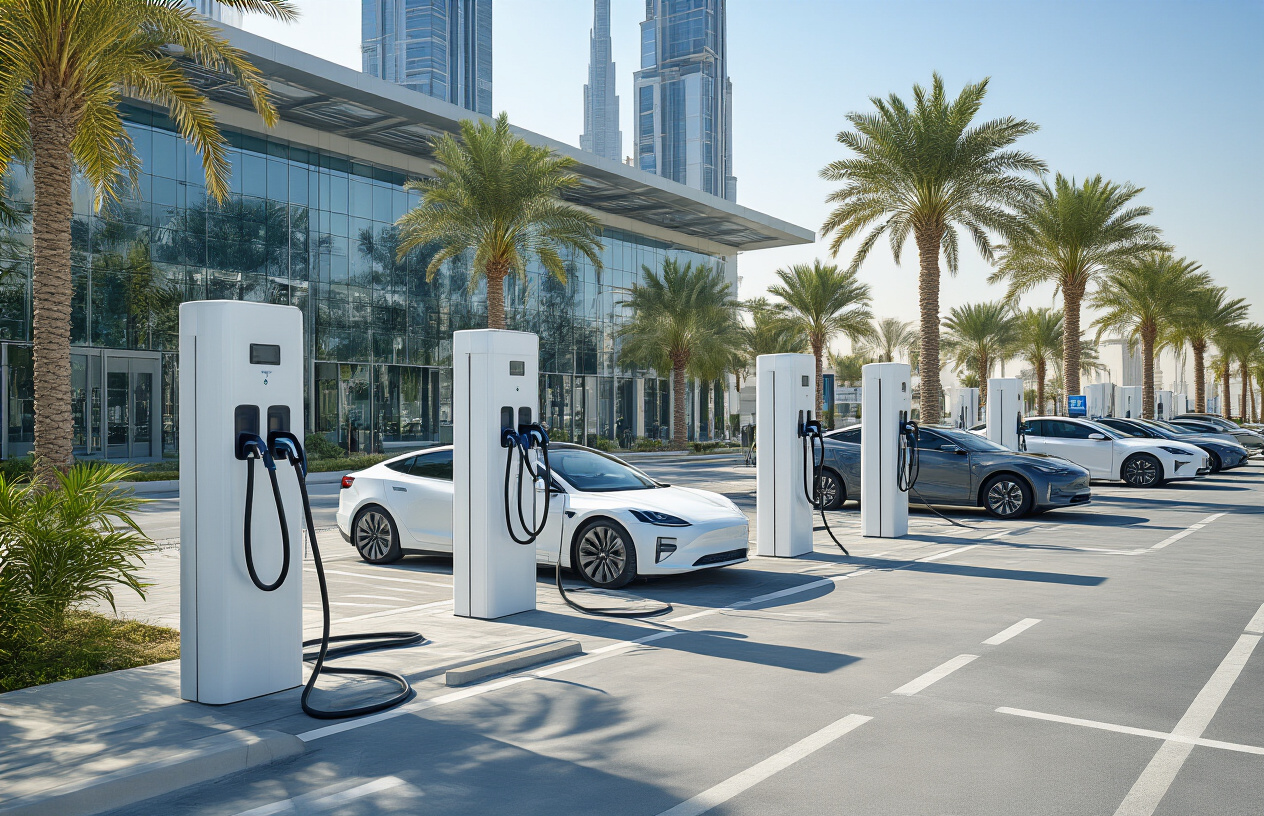
Rapid Charging Networks Along Major Highway Corridors
Gulf countries have launched ambitious plans to install fast-charging stations every 50-100 kilometers along their major highways. The UAE leads this initiative with ADNOC Distribution’s network expansion, featuring ultra-fast chargers capable of delivering 350kW power output. Saudi Arabia’s National Electric Vehicle Infrastructure Company (NEVIC) has committed to establishing charging points across the Kingdom’s extensive road network, connecting cities like Riyadh, Jeddah, and Dammam.
These highway charging stations typically offer multiple charging standards including CCS, CHAdeMO, and Tesla connectors to accommodate various vehicle types. Many locations provide amenities like convenience stores, restaurants, and prayer facilities, making the charging experience more convenient for travelers. Qatar has integrated highway charging stations with their existing Woqod fuel stations, creating hybrid energy hubs that serve both conventional and electric vehicles.
The strategic placement of these chargers addresses range anxiety – one of the primary concerns preventing widespread EV adoption. Advanced booking systems and real-time availability apps help drivers plan their journeys more effectively.
Urban Charging Stations in Shopping Centers and Business Districts
Shopping malls and business districts across Gulf cities have become prime locations for charging infrastructure deployment. Major retail chains like Mall of the Emirates, City Centre malls, and Landmark Group properties have installed Level 2 and DC fast chargers in their parking facilities. These installations provide 2-4 hours of charging time – perfect for shoppers and office workers.
Business districts in financial hubs like DIFC in Dubai, West Bay in Doha, and King Abdullah Financial District in Riyadh feature premium charging services with valet charging options. Some locations offer subscription-based charging plans for regular users, making urban EV ownership more practical and cost-effective.
Smart charging systems integrated with mobile payment platforms allow seamless transactions. Many stations include digital displays showing charging progress, estimated completion times, and nearby amenities. The integration with loyalty programs at major retailers provides additional incentives for EV owners to choose specific shopping destinations.
Home Charging Solutions for Residential Communities
Residential charging infrastructure varies significantly across Gulf nations, with newer developments leading the adoption curve. High-end residential compounds in Dubai, Abu Dhabi, and Riyadh increasingly include EV charging provisions in their master plans. These range from basic 7kW AC chargers to more sophisticated 22kW three-phase systems.
Apartment complexes and villa communities are retrofitting existing parking areas with charging stations. Property developers now market EV-ready homes as premium features, installing dedicated electrical circuits and charging equipment during construction. Some communities offer shared charging facilities managed through resident apps that handle scheduling and billing.
The challenge lies in older residential areas where electrical infrastructure requires significant upgrades. Government initiatives in the UAE and Saudi Arabia provide subsidies for residential charging installations, covering up to 50% of equipment and installation costs. Utility companies offer special EV charging tariffs with reduced rates during off-peak hours, making home charging more economical.
Workplace Charging Programs for Corporate Fleets
Corporate fleet electrification drives workplace charging program development across Gulf businesses. Major companies like Aramco, ADNOC, and Qatar Energy have installed charging stations at their facilities to support employee EV adoption and fleet conversion plans. These programs often include preferred parking spots for EVs and free charging as employee benefits.
Industrial zones and free trade areas like Jebel Ali in Dubai and King Abdullah Economic City in Saudi Arabia offer centralized charging solutions for multiple businesses. Shared charging facilities reduce individual company infrastructure costs while providing reliable charging access for employees and fleet vehicles.
Fleet management companies partner with charging network providers to offer comprehensive solutions including vehicle leasing, charging infrastructure, and maintenance services. These turnkey programs help businesses transition to electric fleets without significant capital investments or operational complexity.
Government entities lead by example, with many ministries and public sector organizations installing workplace charging stations. Dubai’s Roads and Transport Authority (RTA) and Saudi Arabia’s Public Transport Company operate electric bus fleets supported by dedicated depot charging facilities, demonstrating large-scale fleet electrification success.
Economic Benefits of Electric Transportation Transition

Reduced Dependency on Oil Imports for Transportation Fuel
Gulf countries face a surprising paradox: despite being major oil producers, they often rely heavily on refined petroleum imports for transportation needs. The shift to electric transportation creates a strategic opportunity to redirect domestic crude oil production toward more profitable export markets rather than domestic consumption. Electric vehicles powered by renewable energy or natural gas-generated electricity allow nations to keep more oil available for international sales, maximizing revenue from their natural resources.
Countries like the UAE and Saudi Arabia can capture higher value from each barrel by selling crude oil internationally rather than refining it domestically for transportation fuel. This economic optimization becomes particularly valuable when global oil prices are high, as nations can export premium crude while meeting domestic transportation needs through electricity generated from cheaper natural gas reserves or solar installations.
Job Creation in Green Technology and Maintenance Sectors
The electric transportation revolution spawns entirely new employment ecosystems across Gulf nations. Manufacturing facilities for EV components, battery production plants, and charging equipment assembly create thousands of skilled manufacturing jobs. Local assembly of electric buses, delivery vehicles, and passenger cars requires specialized technicians, quality control specialists, and logistics coordinators.
Maintenance and service sectors experience dramatic transformation as electric vehicles require different skill sets than traditional combustion engines. New career paths emerge for battery technicians, charging station installers, electrical system diagnostics specialists, and software maintenance professionals. Training programs develop rapidly to meet demand for certified EV mechanics and electrical system experts.
Solar panel installation and maintenance for charging infrastructure creates additional employment opportunities, particularly in regions with abundant sunshine. Grid integration specialists, energy storage system technicians, and smart charging network operators represent growing professional categories that didn’t exist in traditional transportation systems.
Lower Total Cost of Ownership for Fleet Operators
Commercial fleet operators discover significant cost advantages when transitioning to electric vehicles. Electricity costs substantially less per mile than gasoline or diesel fuel, with some Gulf countries offering preferential rates for EV charging during off-peak hours. Fleet managers report fuel cost reductions of 60-70% compared to conventional vehicles, creating immediate operational savings.
Maintenance expenses drop dramatically due to fewer moving parts in electric drivetrains. Fleet operators eliminate oil changes, transmission repairs, exhaust system maintenance, and many engine-related service requirements. Brake systems last longer due to regenerative braking, while electric motors typically require minimal maintenance over their operational lifetime.
| Cost Category | Traditional Fleet | Electric Fleet | Annual Savings |
|---|---|---|---|
| Fuel Costs | $45,000 | $15,000 | $30,000 |
| Maintenance | $12,000 | $4,000 | $8,000 |
| Insurance | $8,000 | $7,000 | $1,000 |
| Total | $65,000 | $26,000 | $39,000 |
Government incentives, tax breaks, and reduced registration fees often sweeten the financial proposition for commercial operators. Many Gulf states offer accelerated depreciation schedules for electric fleet vehicles, creating additional tax advantages for businesses making the transition.
Increased Energy Security Through Diversified Transportation Systems
Electric transportation systems enhance national energy security by creating multiple pathways for powering mobility needs. Rather than depending solely on refined petroleum products, countries can power transportation through natural gas power plants, solar installations, nuclear facilities, or imported electricity. This diversification reduces vulnerability to supply chain disruptions in any single energy source.
Smart grid integration allows transportation systems to support overall electrical grid stability. Electric vehicle batteries serve as distributed energy storage, helping balance supply and demand fluctuations from renewable energy sources. During peak solar generation periods, excess electricity charges vehicle fleets, while vehicles can potentially feed power back to the grid during high-demand periods.
Strategic petroleum reserves become more effective when transportation systems don’t depend entirely on oil products. Countries can maintain smaller emergency fuel stockpiles while ensuring transportation networks remain operational during regional conflicts or supply disruptions. This flexibility strengthens national resilience and reduces the economic impact of global energy market volatility.
Cross-border electricity trading creates additional security benefits, as countries can source transportation energy from multiple regional partners rather than relying on oil imports from specific nations or shipping routes.
Environmental Impact and Climate Goals Achievement
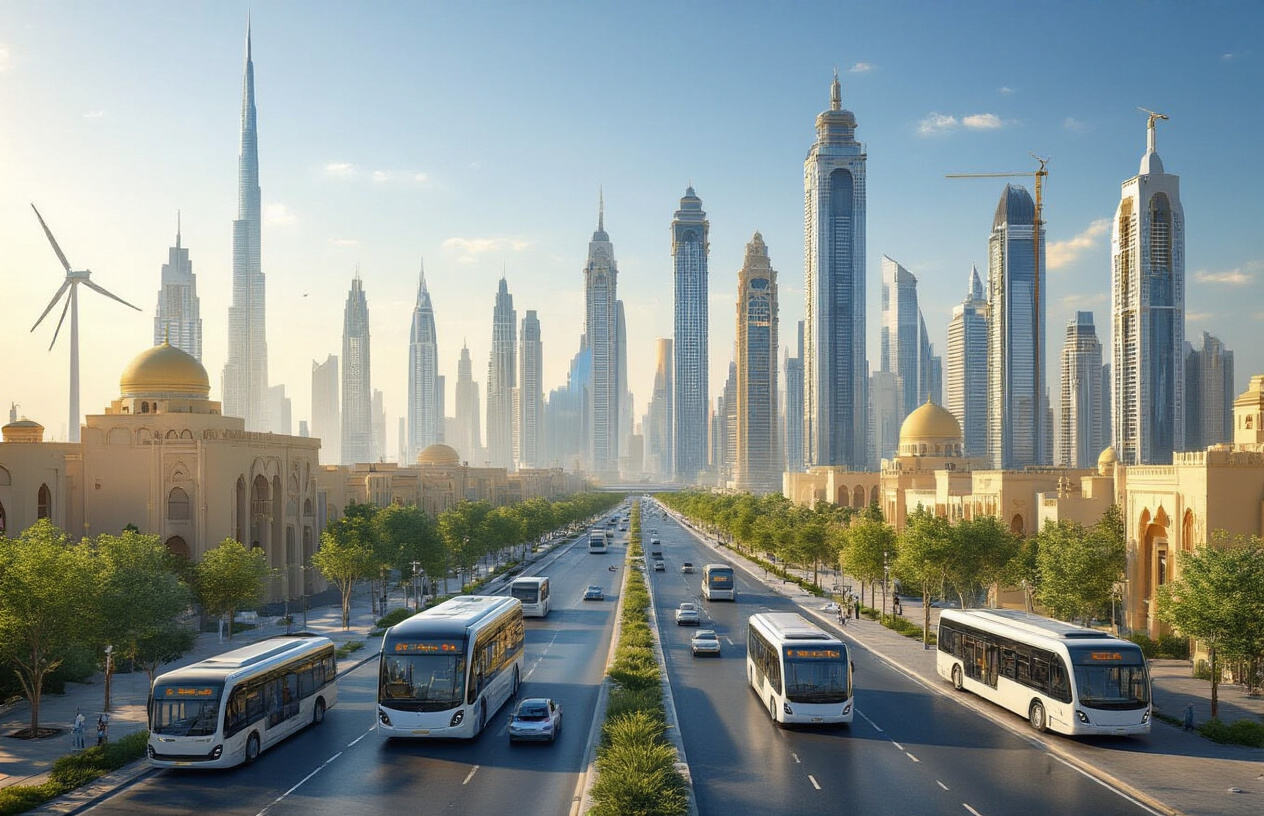
Significant Reduction in Carbon Emissions from Transportation
Gulf countries are experiencing dramatic shifts in their carbon footprints as electric vehicles gain traction across the region. Transportation accounts for roughly 25-30% of total carbon emissions in most GCC nations, making the transition to electric mobility a crucial component of decarbonization strategies.
The UAE leads this transformation with ambitious targets to reduce transport emissions by 40% by 2030. Early adoption data shows that each electric vehicle replaces approximately 4.6 tons of CO2 emissions annually compared to conventional gasoline vehicles. Saudi Arabia’s Vision 2030 includes plans for 30% of vehicles in Riyadh to be electric by the end of the decade, potentially eliminating millions of tons of carbon emissions from the kingdom’s most populous city.
Qatar’s National Vision 2030 emphasizes sustainable transport solutions, with electric bus fleets already operating in Doha reducing urban transport emissions by 15% since implementation. The country’s LNG-powered hybrid systems serve as stepping stones toward full electrification, cutting emissions by up to 60% compared to diesel alternatives.
Oil-rich nations like Kuwait and Bahrain are paradoxically embracing electric transportation not just for environmental reasons, but as strategic moves to preserve oil reserves for export while meeting domestic climate commitments. Kuwait’s recent pilot programs with electric government fleets have demonstrated emission reductions of over 3,000 tons of CO2 annually across just 500 vehicles.
Improved Air Quality in Major Urban Centers
Major Gulf cities are witnessing measurable improvements in air quality as electric vehicle adoption accelerates. Dubai’s Air Quality Index has improved by 12% in districts with higher EV concentrations, particularly in areas like Dubai Marina and Downtown Dubai where charging infrastructure is most developed.
Riyadh, historically challenged by dust storms and vehicle emissions, reports significant decreases in nitrogen oxide levels along major corridors where electric buses operate. The city’s real-time air monitoring systems show 20% lower particulate matter concentrations during peak hours in areas served by electric public transport.
Health benefits are becoming apparent across the region. Abu Dhabi’s Department of Health reports declining respiratory illness rates in neighborhoods with higher electric vehicle adoption. Children’s asthma rates have decreased by 8% in areas where electric school bus programs operate, providing compelling evidence of the direct health impacts of cleaner transportation.
Doha’s preparation for major international events has accelerated air quality improvements through electric vehicle integration. The city’s comprehensive monitoring network shows consistent reductions in harmful pollutants, particularly during high-traffic periods when electric vehicles make up larger portions of the traffic mix.
Supporting Paris Agreement Commitments Through Clean Mobility
Electric transportation serves as a cornerstone for Gulf nations’ Paris Agreement obligations, with each country integrating mobility electrification into their Nationally Determined Contributions (NDCs). The UAE’s NDC includes specific transport sector targets, with electric vehicles contributing an estimated 35% of the country’s overall emission reduction goals by 2030.
Saudi Arabia’s circular carbon economy approach positions electric transportation as a key enabler for achieving net-zero emissions by 2060. The kingdom’s NEOM project showcases this commitment with plans for a completely electric transportation ecosystem, serving as a testing ground for scalable solutions across the region.
Qatar’s Supreme Committee for Delivery & Legacy has established electric transportation as a permanent fixture beyond major sporting events, with infrastructure investments designed to support long-term climate goals. The country’s Natural Carbon Alliance includes specific provisions for transport electrification as part of broader decarbonization efforts.
Regional cooperation through the Gulf Cooperation Council has established shared standards for electric vehicle adoption, creating harmonized policies that support collective climate commitments. Cross-border electric vehicle corridors are being developed to enable regional travel while maintaining emission reduction targets across all member nations.
Challenges and Barriers to Widespread EV Adoption
High Initial Purchase Costs Compared to Conventional Vehicles
The price gap between electric vehicles and traditional gasoline cars remains a major hurdle in Gulf countries. Most EVs carry premium price tags that can be 30-50% higher than comparable conventional vehicles, even after government incentives. This upfront cost difference hits particularly hard in price-sensitive market segments.
The situation gets more complex when considering the total cost of ownership. While EVs offer lower operational costs through cheaper electricity and reduced maintenance, many consumers focus primarily on the sticker price. Gulf buyers often expect immediate value, making the higher initial investment a tough sell despite long-term savings.
Luxury EV models dominate showrooms across the region, but affordable mass-market options remain scarce. This leaves middle-income families with limited choices, effectively pricing them out of the electric transition. Battery costs, though declining globally, still represent a significant portion of vehicle pricing in Gulf markets.
Limited Model Availability Suitable for Gulf Climate Conditions
The extreme heat in Gulf countries creates unique challenges for EV performance that many manufacturers haven’t fully addressed. Temperatures regularly exceeding 45°C put tremendous stress on battery systems, reducing range and lifespan. Most EVs available globally aren’t specifically designed or tested for such harsh conditions.
Current model offerings lean heavily toward luxury sedans and SUVs, with minimal representation in popular vehicle categories like pickup trucks and commercial vans. This gap becomes critical since these vehicle types dominate Gulf roads and serve essential business functions.
Range anxiety intensifies in desert climates where air conditioning systems drain batteries faster than in temperate regions. Many available models struggle to meet the daily driving needs of Gulf residents who regularly travel long distances between cities or to remote locations.
Consumer Awareness and Education Gaps About EV Benefits
Misconceptions about electric vehicles persist throughout Gulf societies. Many consumers believe EVs can’t handle highway speeds or long-distance travel, unaware of modern capabilities. Others worry about battery replacement costs without understanding warranty coverage or actual lifespan data.
The complexity of charging systems confuses potential buyers. Different plug types, charging speeds, and payment methods create barriers for people accustomed to simple gas station transactions. Home charging installation requirements and electrical upgrades add another layer of uncertainty.
Cultural factors also play a role. Car ownership carries social significance in Gulf countries, and some view EVs as compromising on status or performance. Dealer knowledge varies widely, with many salespeople unable to answer basic questions about electric drivetrains or charging infrastructure.
Grid Capacity Concerns During Peak Charging Periods
Power grids across Gulf nations already strain under massive air conditioning loads during summer months. Adding widespread EV charging to evening peak demand periods could overwhelm existing infrastructure. Most people prefer charging at home after work, creating concentrated demand spikes.
Current grid designs prioritize cooling loads over transportation electrification. Upgrading distribution networks to handle simultaneous EV charging requires substantial investment and careful planning. Some residential areas lack adequate electrical capacity for multiple home chargers operating simultaneously.
Smart charging technology remains underdeveloped in the region. Without proper load management systems, uncontrolled charging could destabilize local grids or trigger expensive peak demand charges that get passed to consumers. Utility companies need time and resources to implement the sophisticated systems required for large-scale EV integration.

